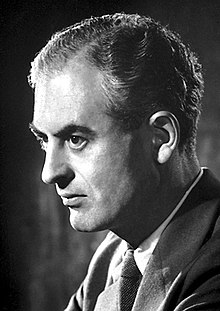Mutation-accumulation theory
The mutation accumulation theory , which also frequently used in German literature English name is mutation accumulation theory ( of aging ), is a 1952 by the British Nobel laureate Peter Medawar established theory to explain the causes of aging . The theory is consistent with the evolutionary theory on which it is based and is one of the evolutionary theories of aging .
description
The mutation-accumulation theory is based on two considerations:
- Alleles can become active in all phases of an organism's life and thus influence the phenotype . This point in time can also be in the old age of the organism, for example.
- The selection is a weaker force in older individuals than in younger ones, since older individuals normally make up a significantly smaller proportion of the total population.
According to the mutation-accumulation theory, aging is the result of a weakened selection effect on late-acting alleles which have some form of fitness-reducing effect.
Almost all animals in the wild die a catastrophic death , for example from accidents, diseases or predators , before they reach the range of the maximum life expectancy (ω). Medawar concluded that in old age there is insufficient selection pressure against aging. The lack of selection pressure called Medawar selection shadow . As a consequence of neglected repair mechanisms, mutations would accumulate in the cells over the life span of the organism (mutation accumulation), which only show their negative effects at an advanced age and there lead to the familiar signs of aging.
Medawar saw the cause of aging in the neglect of homeostasis . According to his theory, the accumulation of mutations is essentially stochastic , that is, according to time-ordered random processes. The mutations only enter the population's gene pool in exceptional cases.
reception
Modern molecular biology has, over time, uncovered some weaknesses in Medawar's theory. Some results with model organisms also contradict the mutation-accumulation theory. Both have led to further developments of the mutation-accumulation theory. These include the theory of antagonistic pleiotropy put forward by George C. Williams and the disposable soma theory by Tom Kirkwood . All three theories taken together are not mutually exclusive. The essential common statement for all three is that the extrinsic mortality risk (external influences that lead to death) is the decisive ultimate factor for the development of the intrinsic aging rate.
Individual evidence
- ↑ a b c P. Dammann: Senescence in African sand graves (Bathyergidae, Rodentia) with special consideration of the genus Fukomys. Dissertation, University of Essen-Duisburg, 2006, p. 10.
- ↑ P. Ljubuncic and AZ Reznick: The evolutionary theories of aging revisited - a mini-review. In: Gerontology 55, 2009, pp. 205-216. PMID 19202326 (Review)
- ^ H. Niedermüller and G. Hofecker: Lifespan: Genetic determination and life-lengthening strategies. In: Molecular medical principles of age-specific diseases. D. Ganten and K. Ruckpaul (eds.): Verlag Springer, 2004, ISBN 3-540-00858-6 , p. 13. Restricted preview in the Google book search
- ^ PB Medawar: An Unsolved Problem of Biology. In: Uniqueness of the Individual. HK Lewis, London, 1952, pp. 44-70.
- ^ EB Edney and RW Gill: Evolution of senescence and specific longevity. In: Nature 220, 1968, pp. 281-282. PMID 5684860
- ^ TB Kirkwood and SN Austad: Why do we age? In: Nature 408, 2000, pp. 233-238. PMID 11089980 (Review)
- ↑ L. Partridge and D. Gems: The evolution of longevity. In: Current Biology 12, 2002, R544-R546. PMID 12194832
further reading
- TC Goldsmith: The Evolution of Aging. Edition 2. Azinet Verlag, 2006, ISBN 0-9788709-0-5 , pp. 39-44. limited preview in Google Book search
- A. Baudisch: Inevitable aging ?: contributions to evolutionary-demographic theory. Verlag Springer, 2008, ISBN 978-3-540-76655-1 . limited preview in Google Book search
